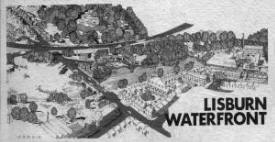
Lisburn Waterfront
Alan M. Cooke
 |
 |
| As existing plans would have the scheme | As it could be with the realisation of environmental and recreational potential |
Work is already under way to change the face of Lisburn.
But now a critical eye has been cast on the recognised plans. A young Carnmoney man sees greater potential for the waterfront area at the foot of Bridge Street.
The existing plans include ring roads on the outskirts of the town, giving a fast-moving traffic flow and a safe, pleasant shopping area. Apart from this, the recreational hasn't really town's structure changed.
IMPROVEMENT
But Alan has drawn up plans which he claims could have greatly imprpved the scheme and given the town a much brighter outlook, both in housing and recreation.
Alan, of Beverley Park, Carnmoney, took Lisburn's plans as the subject for his thesis for the Degree of Master of Science in Architecture. He entitled his thesis "A Country Park within an Urban Environment" and concentrated on the Lisburn waterfront.
The thesis was accompanied by three drawings, illustrating the waterfront as it exists, as it will be when present plans are complete and as he thinks it should be.
Although work has started, Alan sees terrific scope by which the river and its environs, at the historical, recreational and residential heart of the town, could have been been developed to their optimum potential for everyone's benefit.
COMMENT
Explaining his own thoughts and plans for the area, Alan comments:- "As a park, the river area could directly serve every public sector housing estate in Lisburn.
"Slip roads to the throughpass could have been repositioned away from the quayside, thereby saving the area as an integral visual and recreational element in the town. The island could have been conserved as the cultural and social leisure centre for Lisburn, embodying a craft centre, Lagan navigation museum, Lisburn museum, library, club and society rooms and a theatre to mention a few of its possibilities within the framework of the main buildings.
"Housing in the area could have retained its character at no extra cost than redevelopment, reconditioned with toilet, bathroom and bedroom rear extensions.
BENEFITS
"The benefits of such a scheme could have been nationwide and cost incurred would have been similarly spread with the government' and schemes such as Enterprise Ulster could have provided much of the effort."
Criticising the scheme, Mr. Cook feels the people of Lisburn should have been given a chance to decide whether they wanted the most potentially beautiful area of the town and its most beneficial in recreation terms, to be revived and saved or whether they wanted the everlasting and sterile environment of a dead river, tarmac and traffic.
Alan Cook explains his criticism in the last part of his thesis:
"The view across the river to the quay and beyond up Quay Street used to be enclosed at Bridge Street by terraced housing.
The view now extends' aimlessly across a demolition car park to the town's gasworks.
"The houses on the left of. Bridge Street, originally the town's main thoroughfare to Dublin, have been razed to the ground across to Laganbank Road. Gone is Coulson's Damask Weaving factory where in 1764, one hundred years before weavers nationally achieved full time employment, "upwards of 500 workmen residing in or contiguous to Lisburn are daily employed."
"The reason for demolition is not for redevelopment but to clear the way for the coming Lisburn Urban Throughpass. The M.1. motorway failed to relieve traffic congestion in the streets of the town, so now a shorter by-pass is envisaged to circle the south of the town and make it easier and faster for vehicles to move into and around Lisburn. In the process Castle Gardens will be decimated and cut off from the river; the Quay and Quay Street will disappear under the main road as will warehouses, pubs and shops; the dry dock, built by Henry Mulholland in 1837 to enable barge repairs and maintenance and now surrounded by trees in a quiet backwater off the river, will be buried by a slip road; the Union Bridge dating from 1884 will survive but with a new cantilevered top section for four lane traffic - and the 'Down' side, where buildings are listed or mentioned by the Ulster Architectural Heritage Society, will be redeveloped.
"The effect of a dual carriageway partly elevated with a traffic-lights - slip-road junction at the bottom of Bridge Street is ominous in the extreme. The wooded Antrim riverside and the Lisburn Quay are inexorably heading for extinction as yet another decision or subservience to the integral combustion engine is taken.
EXTINCTION
"But, happily, in the midst of this riot of change which is to befall the Lisburn waterfront and its community, people and their hedonistic tendencies have not been forgotten: I am assured that between the sliproad off the new throughpass and the river there will be a paved promenade with lights. This human scale concrete edging will open up the area for walks (presumably to see the traffic, inhale nice fumes, or look for the ghosts of bargees). Anyway people love a walk by a river!
"The throughpass is coming, but its proposed treatment is reminiscent of the fate suffered by Carrickfergus in the sixties where the inhabitants are forced through tunnels to reach their own concretized and wind-swept sea front. I suggest that the people of Lisburn, if they must suffer this disruption of an area of such intrinsic interest, deserve a better deal than their friends in Carrickfergus."
Ulster Star
26 October 1973
